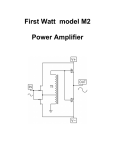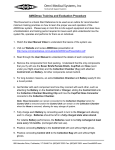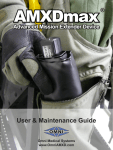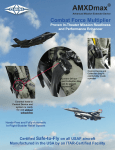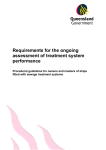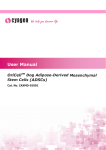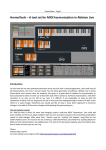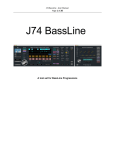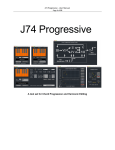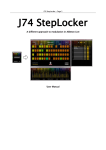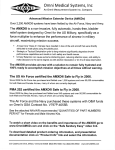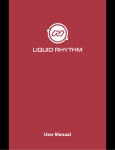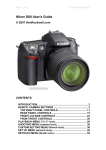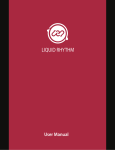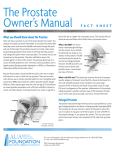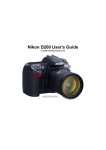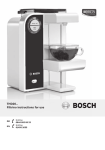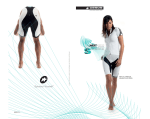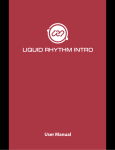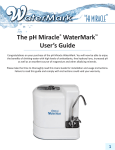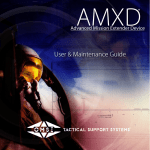Download Female AMXDmax Pilot Training Questions - Answers 1-25
Transcript
Female AMXDmax Training and Evaluation Procedure This Document is a Quick Start Reference to be used as an outline for recommended minimum training practices on how to learn the proper use and operation of the AMXDmax system. Please keep in mind this is Life support equipment and does have a familiarization and training period required to insure each pilot understands how the system fits, operates and performs for them as an individual. 1. Watch the User Manual Video to understand the basics of the system use. 2. Read through the User Manual to understand the details of each component. 3. Remove the components from their packing. Understand that the only components that you fly with are the Boxer Briefs/Female Briefs, Cup/Pad and Hose (worn under your flight ensemble) and the Collection Chamber (Bag) with attached Control Unit and Battery. Other items remain behind or in helmet bag. 4. For long duration missions, an extra Collection Chamber and Battery easily fit into a G-suit pocket. 5. Get familiar with each component and how they connect with each other, such as attaching the Battery on the Control Unit or Charger, sliding the Control Unit onto the Collection Chamber Mounting Clip and how the Cup/Pad Hose Connector connects to the Collection Chamber. Note: Hose Connector can remain connected to the Collection Chamber when the Control Unit is removed and/or the Control Unit can remain on the Collection Chamber when the Hose is removed, allowing for easy storage of system. 6. Fully charge each Battery by connecting each in turn to the Charger and allowing each to charge. Batteries should be left in a fully charged state when stored. For reliable Battery performance, the Batteries need to be fully recharged at least once every 12 months. (recharged after last use). 7. Practice connecting and disconnecting all components with and without flight gloves. • • • Battery to Control Unit Control Unit to Collection Bag Hose Connector to Clection Bag/Conrol Unit 8. Test the operating performance of the system with salt water to understand how it will work in use. • • • • • • Add approximately 10 grams (tea spoon) of salt to 400 ml (12 fl oz) of water. (Simulating Urine for the Cup/Pad Urine Sensor). Connect system components together with a charged Battery and check that Collection Chamber twist valve is closed (twist clockwise). The green Battery Status Light will flash slowly when all components are connected and indicating it is ready to use. Slowly pour salt water into Cup/Pad. The system will activate automatically, pumping the salt water from the Cup/Pad to the Collection Chamber. Empty the Collection Chamber when finished and make sure to close the twist valve. 9. Make sure that the supplied Female Briefs fit properly. The Briefs should fit snuggly and comfortably, they are designed to hold the Pad securely in place. 10. Practice inserting the Pad into the Briefs aligning the Pad Location with reference to Hips or Pelvic as determined during ejection seat Pad Location Training (as demonstrated in user manual and training video). The Pad can be placed in the Briefs before donning flight gear or after, allowing the pilot to put Pad into place just prior to going to the flight line without undressing. 11. Practice using the system – This is a critical part of the AMXDmax training, to understand it, practice using it and to be completely comfortable with the system before ever trying it in an aircraft as you would with other Life Support Equipment. • • • • • First use of the system often works best sitting on a toilet seat with seat top cover down. (The Pad needs support under it to push it into contact with female body and seal). The Control Unit will come on and pump urine out of Pad to Collection Chamber, when Urine is detected in the Pad by the integrated Urine Sensor. Add flight suit and use system in Ejection seat or Egress trainer if available and repeat actually using the system a couple of times until comfortable with its performance and with the positioning of the Pad. Follow the directions in Manual and Video instructions on how to properly position Pad (locate it in reference to anatomy, hips - pelvic) for best performance at in the ejection seat angle for their aircraft. The Pad needs to be placed with its Gold Urine Sensor positioned at the lowest point in the Ejection Seat (this will vary depending on the Seat angle). Once comfortable with the performance of the system and the positioning of the Pad add other flight gear (G-suit, cold weather gear. Etc) and repeat using the system on the ground in ejection seat or egress trainer with harness connected (simulated flight conditions) until comfortable with its operation. Read the Female AMXDmax USER Training Questions and Answers January 23, 2015 Once completely comfortable with the operation and performance of the AMXDmax system should you proceed to conduct flight trails. Remember to check Battery Status before use. Because every pilot’s body size and shape and gear is slightly different it is critical to address position, fit, comfort and proper operational protocols when training on the ground before flying with the AMXDmax. Female AMXDmax USER Training Questions and Answers January 23, 2015 The following questions are from pilots that were deployed without any prior education, training or practice before given the AMXDmax system to use on deployed sortie. The experience of these female pilots speak to the importance that every pilot needs to get their AMXDmax system at least 3 months before they are deploying so they can properly train and experience using the system under training sortie conditions, like they are required to do with all other aircrew flight equipment, well before ever being deployed. The AMXDmax Training and Evaluation Procedure document included in each AMXDmax CSK Control Starter Kit provides an outline of the minimum training requirements recommended. The ACC/AT3 Letter of Safe to Fly certification stresses the importance of proper training on this very individual and personal physiological and essential Aircrew Flight Equipment. Omni’s mission is to support all aircrew and help them understand how the AMXDmax flight equipment works for them as individuals. The Data Points provided will help the user better understand what is needed in their training, will help to understand what the specifications mean and how they relate to each user’s performance issues. The following responses to the Data Points provided are to help users to better understand the AMXDmax performance specifications and limitations. Each individual pilot should learn how to maximize the system capabilities to their individual physiology well before they are deployed. Question 1) Reusable Female Pads How many times can they be cleaned and reused? - Based on the data from the website/training manuals, "the Female Pad can be reused in up to 5 flights or 15 days with proper cleaning" Untrained Deployed pilot feedback - After a month of flying 7-8 hour missions (plus 2 hours of ground wear in 100+ deg heat), and with proper cleaning, we are using the pads an average of 2 flights. Even when we use the peroxide on the sides of the cloth section, after wearing them for 10+ hours, they are not really sanitary to use for more than 2-3 flights. Omni Answer 1) The pads are working as expected under the mission conditioned mentioned. The specification states reusable UP TO 5 flights, depending on the user, for the typical training sortie, means not recommended for more than 5 uses for sanitary reasons. Mission length, heat, and number of uses during mission are all factors on how long they will last. We include in our Quotes for Female Pads and Collection Bags that Omni recommends that the Pads and Bags are cleaned and reused for a maximum of 2 times during ground training, practice and actual flight testing period. Once users have completed training, have practiced and are comfortable with how to position the pad for their individual physiology, seat configuration, the systems performance and proper cleaning, the Pads are designed to last for up to 5 flights each and Bags for up to 10 flights for normal 3-4 hour training sorties or for 2 to 3 flights for longer duration deployed missions. Question 2) How Long do the Batteries last -Per the manual, "Fully charged, the battery lasts for up to 12 uses within a 12 hour period". Untrained Deployed pilot feedback -From the 3 of our experiences, the system attempts to keep the pad inflated throughout the sortie. Then during urination use, the battery drains very quickly, easily 1 battery per 7-8 hour mission. Our technique is now to take out the battery, or unplug the pad, to keep the battery to last throughout the sortie. Having both of the batteries while flying a 7-8 hour mission, is sufficient. Bottom line, the batteries don't seem to last as advertised per the manual. Omni Answer 2) The standard Batteries are performing to specifications - this is a training and use issue the pilots seem to have figured out after flying deployed missions. With proper training they would have realized the following before deploying: The Female System is designed to be connected when a pilot needs to relief and disconnected when finished to deflate pad as stated in the training manual on page 22. This preserves battery capacity while not in use preventing the air pump from constantly trying to adjust the air pressure in the pad as the pilot changes altitude. While the system can be left attached and the Female Pad left inflated for the entire mission it will of course drain the battery more than the specification states. It is designed to have the Female Pad deflated while not in use for maximum comfort. Each time a pilot relieves their bladder it will take a different length of time to void. This, of course, is based on how full their bladder is and also the level of stress they are experiencing at the time, along with attention to mission. This is normal and natural. Therefore the actual time for each bladder relief for each pilot is different each time they void. Many users take 3 to 5 minutes to empty their bladder depending on the above circumstances. To set a standard the Air Force’s performance specification for the AMXDmax calls for a minimum quantity of 12 30 second (750 ml) bladder relief uses after each inflation of the pad (12 pad inflations) per battery charge during 12 hour period with the pad disconnected in between each use. Every AMXDmax standard battery is tested during final inspection for a qty of 12 - 1 minute (1500 ml) uses and 24 pad inflations – a 2 times safety factor over the operational specification. Since the length of time that each pilot takes to relieve is different, this is something to be figured out during training, allowing each pilot to understand how it works for them. User feedback has shown that each pilots bladder relief time will shorten as they become more comfortable with using the system. The AMXDmax Training and Evaluation Procedure Document, does recommend bringing the second battery and extra collection bag on long duration missions. The Female Control Unit systems now include one Standard battery (350 mah) and one Extended Capacity Battery (560 mah) that provides 50% greater capacity. The extended battery actually provides over 12 – 2 minute (3000 ml) uses and 48 pad inflations over a 12 hour period ( 4 times spec) for those extra long duration missions. Question 3) How do Collection Bags Air Vents work -The air vents seem to work intermittently. Half of the time, the air vent lets the excess air out while using the AXMD. Untrained Deployed pilot feedback -On multiple occasions, the air vent hasn't worked properly and the bag inflates to capacity with air, appearing like it may burst. Sometimes it works to squeeze the bag, to force the air out. Other times, we've had to invert the bag & use the drainage valve to let out air. Omni Answer 3) The bag will note burst. This is a typical training issue. The air filters are designed to let out excess air during bladder relief as the urine stream is not continuous so air gets pumped in as well. Depending on Pad position and urination rate, and how many times the user stops and starts to urinate during each bladder relief, the Control Unit may be pumping more air than normally experienced. Each time the sensor in the pad stops detecting urine it runs on for 3 seconds to clear out and residual urine in the Pad and hose. If the user stops 5 times during one bladder relief the Control Unit will be pumping and axtra 15 seconds or 1500 ml/4 = 375 ml of air into the Bag. Omni recommends the pilot try to adjust the pad location ever so slightly using pelvic tilt when finished bladder relieving to see if this stops the pump. The control unit continues to run the pump for a full 3 seconds after the Pad Urine Sensor is clear to remove residual urine form the Pad and Hoses. Experience along with proper pad location will resolve this issue. The New Collection Bags have 4 air filters so it is unlikely that urine inside the bag can block the filter and prevent air from exiting the bag. Question 4 Pump Flow rate The advertised flow rate is "1.5 Liters Per Minute". Untrained Deployed pilot feedback There is no way to tell if we're exceeding this, but we've all now adopted the technique of urinating in short iterations to not overflow the pad. In our opinion, this is not a sustainable technique and recommend to the company to increase the flow rate capacity. -Each of us had issues with the pad overflowing and not keeping up with capacity, when we first started using it. Omni Answer 4) We have found through clinical trials, ground training and pilots using the system with over 7 years of female AMXD and AMXDmax use, once a pilot has a chance to properly train and practice using the system, they can just relax without pushing and the system will keep up with flow rate when the Pad is properly positioned. The Performance specification is for 1.5 liter per minute pump rate and we test this multiple times throughout production and again during 12 hour final inspection performance testing. This pump flow rate was arrived at based on acceptable performance criteria for 90% of test subjects and included other factors such as system Size, Weight, Battery Capacity and Cost. Everyone urinates at a different rate. The original Air Force Specification requirement was 1 liter per minute – but Omni discovered during clinical trials that the spec needed to be changed to 1.5 lpm. Training is critical to help with this as most pilots have been using piddle pack or diaper - hold their bladder relief until they really have to go and then cannot control how fast they go, usually pushing the urine out in relief and to speed up the process as quickly as possible. There are some pilots that do have higher initial urine flow rate than the 1.5 lpm pump. They will need to practice to limit or stop flow a couple of times at the beginning but this should not cause any pain if the pilot is not waiting until their bladder is over full. It is good practice for a pilot to relieve bladder long before they are get uncomfortable. Proper Training with the AMXDmax is critical for each pilot and will allow them to remain properly hydrated at all times. Operational feedback from both female and male pilots has shown that using the AMXDmax to stay properly hydrated provides a pilot with significant Tactical Advantage.





